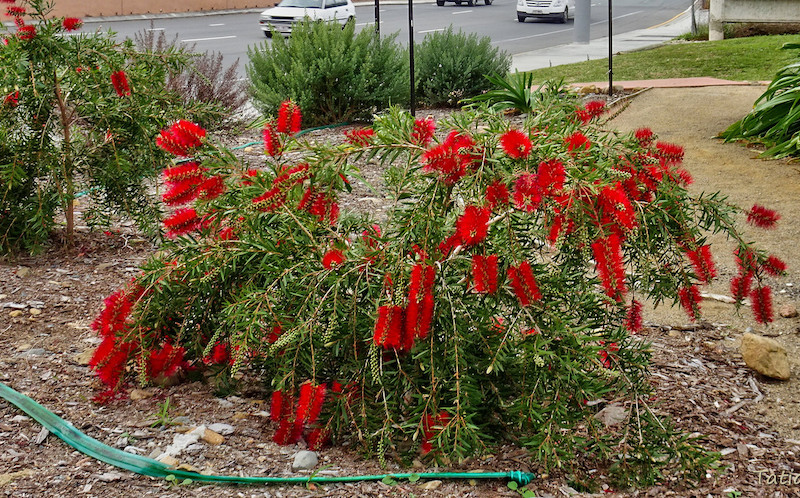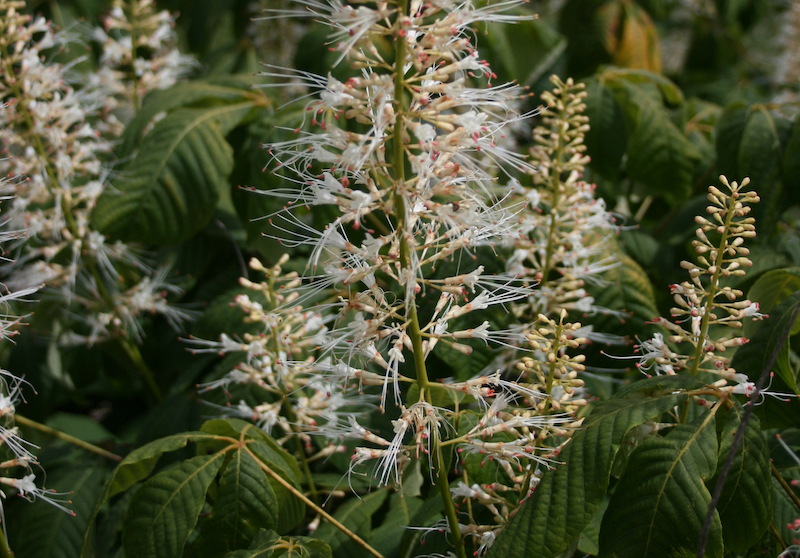The correct watering schedule for a Bottlebrush shrub depends greatly on which species you are growing. Callistemon spp. are natives of Australia and highly drought tolerant after they have established in the garden. The North American native Bottlebrush Buckeye (Aesculus parviflora) on the other hand prefers a more shaded location with soil that is consistently moist.

Photo by Tatters, unedited, Flickr, Copyright Attribution-ShareAlike 2.0 Generic
How To Tell If Bottlebrush Needs Watering
Callistemon spp. are broadleaf evergreens that are able to tolerate much drier soil conditions. The long, lance-shaped leaves are tough and will not readily show symptoms of dryness like a deciduous shrub. Slowed growth and leaves that are brown and crisp are the most common signs that the broadleaf evergreen needs more water. Overwatering is more likely to occur and can lead to slowed growth, fungal diseases of the roots, and eventually death of the shrub. Mulching with organic compost or finely shredded arborist chips helps to keep the soil around the roots cool and will improve drainage as it decomposes into the garden soil.
Aesculus parviflora, the Bottlebrush Buckeye, has deciduous leaves and will let you know quickly that it needs supplemental watering. The leaves and any flower spikes will droop and older leaves will turn yellow and fall off.

How Often To Water Bottlebrush
All shrubs will require supplemental watering until they have established and matured. For the first year after planting, allow for 1 inch of water per week. This amounts to approximately 1-2 gallons of water and is best applied with soaker hoses or drip irrigation. Both of these watering methods are extremely efficient and reduce the amount of water evaporation in the atmosphere.
After the shrubs are established, the evergreen Callistemon spp. Will require very little supplemental watering. Mulching with organic material helps to retain moisture in the soil and will allow the shrubs to go for longer periods without supplemental irrigation. The Bottlebrush Buckeye will require supplemental watering throughout the summer months. Keep the soil evenly moist by watering 1-2 times a week with 1 inch of water total.
Callistemon makes a great container plant for a hot patio or deck. A thorough watering about twice a week will keep the shrub healthy and happy. Ensure that the drainage of the pot is excellent and place the pot in an area where water does not collect.
Best Time To Water Bottlebrush
The best time of day to water ornamental shrubs is early in the morning. Water is better absorbed by soil that is still cool from the night or damp from morning dew. Shrubs can run the risk of contracting fungal diseases and mildew if their leaves are not given enough time to dry before nightfall.
Generally, plants are slower to dry during the early spring or fall when the day and nighttime temperatures are cooler. Late evening watering in the summer can be a good way to revive a shrub that needs watering. Keep the foliage as dry as possible and water the plant slowly with a soaker hose or a garden hose set to deliver a trickle of water.
How to Water Bottlebrush
Step 1 - Evergreen Bottlebrush, Callistemon spp., are drought tolerant at maturity.
Allow time for the soil to dry between waterings to ensure that the shrub is not overwatered. One half an inch of water a week is a good amount of water for a healthy, mature Callistemon.
Step 2 - Bottlebrush Buckeye requires evenly moist soil at all times.
Aesculus parviflora is native to woodlands where the soil is rich and damp, but not boggy or waterlogged. Provide one inch of water a week, and mulch the root zone with organic compost or finely shredded arborist chips to keep the soil cool and moist.
Step 3 - Water potted Callistemon about twice a week in the summer or whenever the top layer of the soil has dried out.
Bottlebrush Watering Tips
- Callistemon bottlebrush develops drought tolerance
- Bottlebrush buckeye grows best in part to full shade
- Bottlebrush buckeye requires soil that remains moist while still being free draining.
 |
Author Robbin Small - Published 5-14-2023 |
